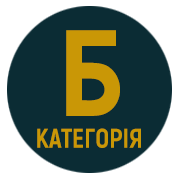THE ARTISTIC POTENTIAL OF INTEGRATIVE BIONICS AS A RESOURCE FOR SUPPORTING AND DEVELOPING THE CREATIVITY OF HIGHER EDUCATION STUDENTS
DOI:
https://doi.org/10.32782/academ-ped.psyh-2025-1.29Keywords:
higher education, integrative bionics, creativity, artistic potentialAbstract
The purpose of the article is to attract attention to the approach to determining the artistic potential of integrative bionics as a resource for supporting and developing the creativity of higher education students (on the examples of teaching in medical and artistic institutions). The research methodology is the introduction of knowledge in integrative bionics with the development of an appropriate philosophical paradigm based on systematization and comparative analysis of the impact of its teaching based on the principles of general systems theory. The scientific novelty of the work is that for the first time the philosophical paradigm of integrative bionics is applied as a means of interdisciplinary integration of knowledge in the training of specialists. Conclusions. The potential of integrative bionics is determined by a reliably stable improvement in the performance of higher education students, increasing their motivation to master knowledge from the large information flows of our time. The effectiveness of the implementation of knowledge in integrative bionics is associated with a student-centered approach to learning in combination with the humanistic component of art and the resource of a positive psychological microclimate. The use of the philosophical paradigm of integrative bionics as a means of interdisciplinary integration of knowledge through visual perception of the wonder of the world opens up new horizons for a deeper study of educational components in both medical and art education.
References
Cantner U., Kalthaus M., Menter M., Mohnen P. Global knowledge flows: characteristics, determinants, and impacts. Industrial and Corporate Change. 2023. 32(5). P. 1063–1076. https://doi.org/10.1093/icc/dtad041.
Huang J.-Y., Siao S.-T. Development of an integrated bionic design system. Journal of Engineering Design and Technology. 2016. 14(2). P. 310–327. http://dx.doi.org/10.1108/JEDT-08-2014-0057.
Integrative STEM Education: Bionics for education. FESTO Didactic. FESTO Corporation, 2024. URL: https://stem.festo.com/us/en/home_1/index.html.
Kierszenbaum A.L., Tres L.L. Histology and Cell Biology. An Introduction to Pathology. Philadelphia : Elsevier, 2012. 701 p.
Solyeyko O.V., Tsarenko S.O., Maznichenko O.V., Chernykh M.O., Palahniuk H.O., Sursaieva L.M., Maiko E.V. Landscape therapy: rehabilitation potential in patients with post-infarction cardiosclerosis. Wiadomości Lekarskie. 2024. 77(4). P. 696–702. https://doi.org/10.36740/WLek202404113.
Spencer J. Five Ways to Boost Student Engagement with Flow Theory. 2020. URL: https://spencereducation.com/flow-theory/.
Луцик О.Д., Чайковський Ю.Б. Гістологія, цитологія, ембріологія. Вінниця : НОВА КНИГА, 2018. 608 с.
Сьомка С.В. Біоніка в дизайні середовища : навчальний посібник. Київ : НАКККіМ, 2016. 244 с.
Чайковський Ю.Б., Геращенко С.Б., Дєльцова О.І., Сокуренко Л.М. Скромна чарівність гістології. Ліки України. 2018. Вип. 7(223). С. 57–60.
Чайковський Ю.Б., Геращенко С.Б., Кокряцька В.О., Дєльцова О.І., Сокуренко Л.М. Гістологія: чи потрібна вона лікарю? Мистецтво лікування. 2018. Вип. 3–4(149–150). С. 31–34.








